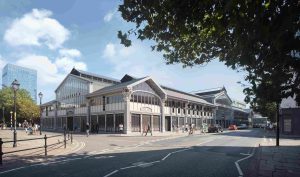Bruntwood’s corridor of opportunity

COLIN Sinclair, director of special projects at North West commercial property group Bruntwood, says Manchester’s Oxford Road ‘corridor’ is one the city’s “most exciting strategic opportunities.”
Already leading the £21m transformation of the Royal Manchester Eye Hospital site into a state-of the art bio-medical innovation centre, in partnership with Manchester Science Parks, Bruntwood is alive to other development opportunities along Oxford Road.
It already has a significant presence on the Corridor. At the city centre end of Oxford Road it has Oxford Place, then the Grade II listed St James’ Buildings, then next door to the soon-to-be vacated BBC North site is the Manchester Technology Centre, which comprises of Oxford House and Armstrong House,
Heading towards the university zone – Bruntwood is hoping to win the mandate for the £30m plus landmark redevelopment project of Manchester Business School.
Mr Sinclair said: “We see the Oxford Road Corridor as central to Manchester’s future progress towards its ambition of being a world-class city”
“From a Bruntwood perspective our goal is to diversify our offering – and we’re underway with that at the Former Royal Eye Hospital – so the Corridor does present a number of really exciting opportunities.”
“We are committed to the Corridor, to supporting science and innovation.”
He said it was crucial that the “right use” was made of the Royal Eye Hospital site, and the scheme would help drive economic growth by fostering innovation.
“The building is in the iconic heart of the clinical campus on Oxford Road, near UMIC (University of Manchester Innovation Centre), so there could not be in a better location to build a world-leading bio-medical facility which is going to be a centre of excellence for clinical trials. The listed frontage of the building is being restored to its former glory.”
“We wouldn’t have wanted to see the building go into inappropriate use like a pub or a bar – it’s important that the use of the building fits in with its position on the latgest clinical campus in Europe and that it will create a significant amount of employment, much of that local.
The new facility should be ready by early 2013, with a large part of the 100,000sq ft building pre-let.
“The whole idea is that an identified group of users already exists for the scheme in terms of clinical trials and training, but they lack the modern world-class facilities that FREH will provide.
“It has also been designed too for small science businesses to move in and grow – it will be the next step after UMIC for University and NHS spin-outs.
“For this reason we don’t want to pre-let the entire space. We want it to be a hotbed for new innovative research. State of the Art Laboratory space is being planned and support will be on hand for pioneering businesses”
He said one major occupier a ‘global business working in the bio-medical field’ is looking at becoming the first tenant for the new space.
As for the name. FREH is only a working title, Mr Sinclair said: “We are looking for ideas for a name that will truly place the building at the centre of the biomedical world. Watch this space.”







